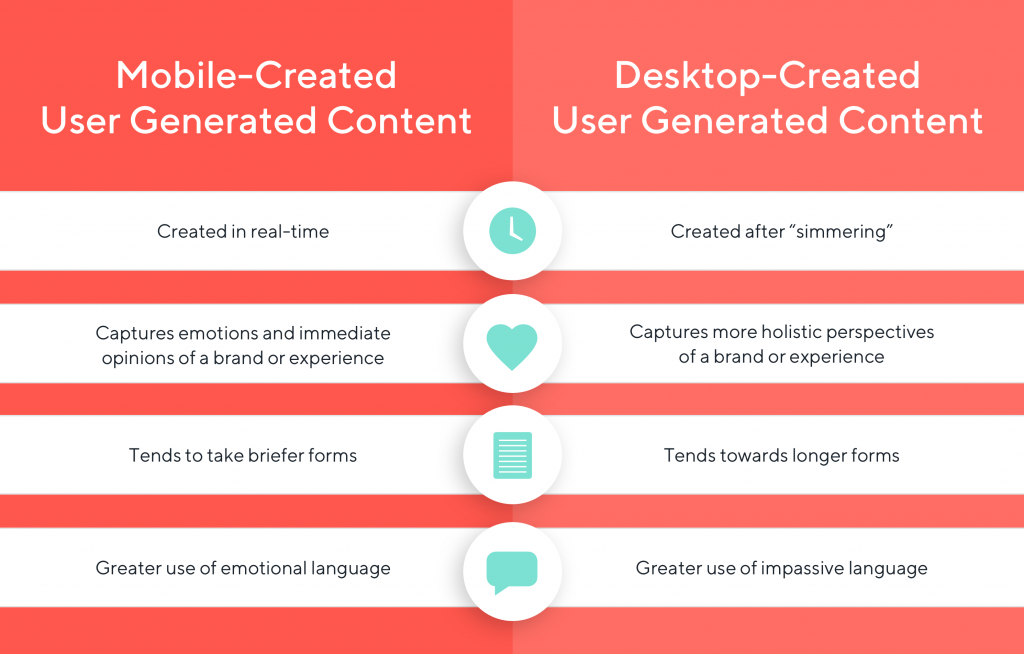Form follows function. The smartphone was designed for convenience, ease of use, and mobility. The desktop -or modern laptop for that matter- was designed as a workhorse; it does the heavy lifting required to sustain an information age society. A 2019 study published in the AMA Journal of Marketing Research explores how user generated content (UGC) differs depending on the device used to create it. There is a device-specific emotional language in UGC that should help guide your understanding of your customers.
The Research
The study, “Selectively Emotional: How Smartphone Use Changes User-Generated Content”, was conducted by Shiri Melumad (Assistant Professor at the Wharton School, University of Pennsylvania), J. Jeffery Inman (Professor at the Katz Graduate School of Business, University of Pennsylvania), and Michal Tuan (Professor at the Graduate School of Business, Columbia University). They analyzed five studies, conducting most of them themselves, to test for use of emotional language in UGC. The big question considers whether “smartphones [are] just an additional platform for creating UGC, or are these devices fundamentally changing the nature of the content…?”
- Study 1: Analyzed two data sets, focused on restaurant reviews, from TripAdvisor. The first set considered over 29,000 reviews in Philadelphia. The second set included over 30,000 reviews in San Francisco.
- Study 2: Students were asked to review their most recent on-campus dining hall experience on either a smartphone or desktop computer.
- Study 3: Participants were asked to complete a “Restaurant Experience Survey” on either a smartphone or desktop.
- Study 4: Participants were asked to write a restaurant review focused on one of three randomly assigned areas: a positive review, a negative review, or their most recent experience either positive or negative.
- Study 5: Analyzed usage of 32 hashtags on Twitter, constituting over 70,000 unique tweets.
Lessons Learned
- Smartphones and Brevity
The inherent convenience of smart devices pushes users towards creating brief, or more concise, forms of content. The emotional language in UGC created on these devices is filled with strong, specific reactions. The word choice may not be the most eloquent, but it is filled with telling and descriptive language. - Desktops and the Long Form
Conversely, desktop-created media tends to feature a more restrained emotional language in UGC. Individuals, generally, have had time to mull over the moment and develop a clearer narrative of the experience. Desktop-Created content focuses more on nuance. It will often delve into the minutiae of the experience, not just focus on the highlights.
- “Temporal Proximity”
Absence makes the heart grow fonder. When people create and share UGC on their smartphones, they capture the moment. Their UGC is often shared in real-time. Desktop-created UGC is often viewed through a gap in time. The user must return to their home or office to create their content. This allows time for the emotions to simmer, perspectives to clear, and time to allow themselves to be suaded by outside influences.
The Comparison

Mobile-Created User Generated Content
- Created in real-time.
- Captures emotions and immediate opinions of a brand or experience.
- Tends to take briefer forms.
- Greater use of emotional language in UGC.
Desktop-Created User Generated Content
- Created after “simmering”.
- Captures more holistic perspectives of a brand or experience.
- Tends towards longer forms.
- Greater use of impassive language.
What this means for Marketers
Calls-to-Action
Consider how your call-to-action feeds into your user generated content needs. If you are seeking images and content that speaks with emotional language, then encourage mobile use. Utilize mobile-first websites and apps that improve the way users share their content. If you are seeking longer-form feedback or written social proof, then incentivize the desktop user to create that content. Allow for desktop-only versions of your site with specific calls-to-action to write out longer reviews.
Social Monitoring
Does your current listening strategy consider whether the content was originally created on a phone or desktop? Social media marketers and managers are often the first line of defense against bad generated media. Work to deploy tools that identify source devices and consider the language difference between each platform.
User Generated Content Marketers
There is an endless number of possibilities and opportunities to leverage user generated content in existing marketing strategies. Mobile-Created content like photos and video capture the emotional authenticity of an experience. Desktop-Created content can speak to the authority and realness of social proof. Being able to identify and separate these types of content is an important skill for any UGC marketers.
Whether the content is created on a phone or desktop, TINT finds, curates, and displays authentic user generated content. Schedule a demo today and explore the many ways to use user generated content in your marketing strategy.



